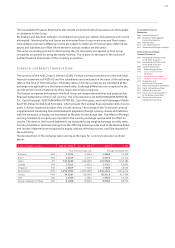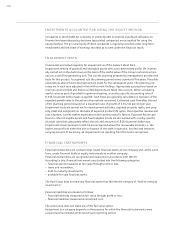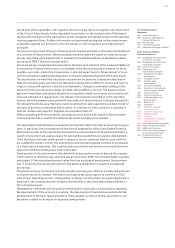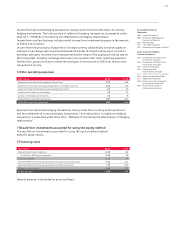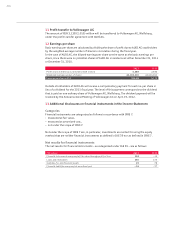Audi 2011 Annual Report Download - page 212
Download and view the complete annual report
Please find page 212 of the 2011 Audi annual report below. You can navigate through the pages in the report by either clicking on the pages listed below, or by using the keyword search tool below to find specific information within the annual report.
209
Consolidated Financial
Statements
188 Income Statement
189 Statement of Recognized
Income and Expense
190 Balance Sheet
191 Cash Flow Statement
192 Statement of Changes in Equity
Notes to the Consolidated
Financial Statements
194 Development of fixed assets
in the 2011 fiscal year
196 Development of fixed assets
in the 2010 fiscal year
198 General information
204 Recognition and
measurement principles
204 Recognition of income
and expenses
204 Intangible assets
205 Property, plant
and equipment
205 Investment property
206 Investments accounted for
using the equity method
206 Impairment tests
206 Financial instruments
209 Other receivables and
financial assets
209 Deferred tax
209 Inventories
210 Securities, cash and
cash equivalents
210 Provisions for pensions
210 Other provisions
210 Liabilities
210 Management’s estimates
and assessments
212 Notes to the Income Statement
218 Notes to the Balance Sheet
227 Additional disclosures
248 Events occurring subsequent
to the balance sheet date
249 Statement of Interests
held by the Audi Group
OTHER RECEIVABLES AND FINANCIAL ASSETS
Other receivables and financial assets (except for derivatives) are recognized at amortized cost.
Provision is made for discernible non-recurring risks and general credit risks in the form of cor-
responding value adjustments.
DEFERRED TAX
Pursuant to IAS 12, deferred tax is determined according to the balance sheet liability-focused
method. This method specifies that tax deferrals are to be created for all temporary differences
between the tax base of assets and liabilities and their carrying amounts in the Consolidated
Balance Sheet (temporary concept). Deferred tax assets relating to carryforward of unused tax
losses must also be recognized.
Deferrals amounting to the anticipated tax burden or tax relief in subsequent fiscal years are
created on the basis of the anticipated tax rate at the time of realization. In accordance with
IAS 12, the tax consequences of distributions of profit are not recognized until the resolution on
the appropriation of profits is adopted.
Deferred tax assets include future tax relief resulting from temporary differences between the
carrying amounts in the Consolidated Balance Sheet and the valuations in the Balance Sheet
for tax purposes. Deferred tax assets relating to carryforward of unused tax losses that can be
realized in the future and deferred tax assets from tax relief are also recognized.
Deferred tax assets and deferred tax liabilities are netted if the tax creditors and maturities are
identical.
Pursuant to IAS 1.70, deferred tax is reported as non-current.
The carrying amount is reduced for deferred tax assets that are unlikely to be realized.
INVENTORIES
Raw materials and supplies are measured at the lower of average cost of acquisition or net re-
alizable value. Other costs of purchase and purchase cost reductions are taken into account as
appropriate.
Work in progress and finished goods are valued at the lower of cost of conversion or net realiza-
ble value. Cost of conversion includes direct materials and direct productive wages, as well as a
directly attributable portion of the necessary indirect materials and indirect labor costs, scheduled
production-related depreciation, and expenses attributable to the products from the scheduled
amortization of capitalized production development costs. Distribution costs, general adminis-
trative expenses and interest on borrowings are not capitalized.
Merchandise is valued at the lower of cost of purchase or net realizable value.
Provision has been made for all discernible storage and inventory risks in the form of appropriate
reductions in the carrying amounts. Individual adjustments are made on all inventories as soon
as the probable proceeds realizable from their sale or use are lower than the carrying amounts
of the inventories. The net realizable value is deemed to be the estimated proceeds of sale less
the estimated costs incurred up until the sale.
Current leased assets comprise leased vehicles with an operating lease of up to one year and
vehicles which are subject to a buy-back obligation within one year (owing to buy-back agree-
ments). These vehicles are capitalized at cost of sales and valued in accordance with the expected
loss of value and likely useful life. Based on local factors and historical values from used car
marketing, updated internal and external information is incorporated into the measurement on
an ongoing basis.






